Ventricular Arrhythmias: Difference between revisions
| Line 12: | Line 12: | ||
| example2 = Ventricular tachycardia on a 12 lead recording[[Image:12lead_vt1.jpg|thumb|Ventricular tachycardia of 140 bpm with a left bundle branch block and a left axis.]] | | example2 = Ventricular tachycardia on a 12 lead recording[[Image:12lead_vt1.jpg|thumb|Ventricular tachycardia of 140 bpm with a left bundle branch block and a left axis.]] | ||
| animation = <flash>file=TenTusscherVT.swf|width=300|height=300|quality=best|align=right||</flash> | | animation = <flash>file=TenTusscherVT.swf|width=300|height=300|quality=best|align=right||</flash> | ||
| animationdesc = | | animationdesc = This movie shows a computer model of ventricular tachycardia in the human heart. The VT in this example is initiated by a ventricular extrasystole and maintained by a re-entry rotor inferior in the left ventricle.<cite>tentusscher</cite> In reality, this is possibly not the etiology of VT in diseased hearts, however it is very illustrative. Read [[Copyright|this]] if you want to use this image in a presentation. [[Media:TenTusscherVT.swf|Link to the file / enlargement]] | ||
}} | }} | ||
Revision as of 09:20, 16 July 2007
Ventricular Tachycardia
Ventricular tachycardia is defined as a sequence of three or more ventricular beats. The frequency must by higher than 100 bpm, mostly it is 110-250 bpm.
Ventricular tachycardias often origin around old scar tissue in the heart, e.g. after myocardial infarction. Also electrolyte disturbances and ischemia can cause ventricular tachycardias. The cardiac output is often strongly reduced during VT resulting in hypotension and loss of conciousness. VT is a medical emergency as it can deteriorate into Ventricular fibrillation and thus mechanical cardiac arrest.
Ventricular tachycardia can be catechorized as follows:
Non-sustained VT
Non-sustained VT is defined three or more ventricular beats with a maximal duration of 30 seconds.
Sustained VT
Sustained VT is defined as a VT of more than 30 seconds duration (or less if treated by electrocardioversion within 30 seconds).
Monomorphic VT
All ventricular beats have the same configuration.
Polymorphic VT
The ventricular beats have a changing configuration. The RR interval is 180-600 ms (comparable to a heart rate of 100-333 bpm).
Ventricular Flutter
Ventricular Flutter is mostly caused by re-entry with a frequency of 300 bpm. The ECG shows a typical sinusoidal pattern. During ventricular flutter the ventricles depolarize in a circular pattern, which prevents good function. Most often this results in a minimal cardiac output and subsequent ischemia. Often deteriorates into ventricular fibrillation.
Ventricular fibrillation
Ventricular fibrillation (VF or V-fib) is chaotic depolarisation of the ventricles. Mechanically this results in an arrested cardiac pump function and immediate death. VF can only be treated by immediate defibrillation. If you consider ventricular fibrillation in a conscious patient, than you should look for a technical problem with the ECG, eg. movement or electrical interference.
Torsade de pointes
| {{{locatieafbeelding}}} | |
| Atrial rate | 60-100 bpm |
| Ventricular rate | 150-300 bpm |
| Regularity | regular |
| Origin | ventricles |
| P-wave | AV-dissociation |
| Effect of adenosine | no rate reduction (sometimes accelerates) |
| Example ECG: An example of Torsade de Pointes. A normal sinus beat is followed by a ventricular extrasystole (shortly after the sinus beat), the compensatory pause results in a longer interval to the next beat. This longer beat therefore has a longer QT interval. The next beat follows shortly therafter, withing the QT interval. Not all ventricular cells have been repolarized by that time and a ventricular arrhythmia results. This short-long-short sequence is typical for Torsades de pointes. | |
Example ECG2: A twelve lead registration of Torsade de pointes. Reprinted with permission Copyright 2001 Texas Heart Institute Khan 
| |
Torsade de pointes is a ventricular tachycardia associated with a long QT time on the resting ECG. Torsade de pointes is typically initiated by a short-long-short interval. A ventricle extrasystole (first beat: short) is followed by a compensatory pause. The following beat (second beat: long) has a longer QT interval. If the next beat follows shortly thereafter, ther is a good chance that this third beat falls within the QT interval, resulting in the R on T phenomenon and subsequent Torsades de pointes. During Torsades de pointes the ventricles depolarize in a circular fashion resulting in QRS complexes with a continuously turning heart axis around the baseline (hence the name Torsade de Pointes). Read the chapter on the Long QT syndrome for an list of causes.
There has been much debate in the Circulation journal among French and American scientist whether one should write Torsades de Pointes or Torsade de Pointes. As for now Torsade is prefered (unless one sees rotations around more than one axis in one episode).Moise
Bidirectional VT
A ventricular tachycardia with a QRS complex that alternates from beat to beat. Associated with digoxin intoxication.
Bundle-branch re-entrant tachycardia
| {{{locatieafbeelding}}} | |
| Atrial rate | {{{atrial_frequency}}} |
| Ventricular rate | {{{ventricular_frequency}}} |
| Regularity | {{{regularity}}} |
| Origin | {{{origin}}} |
| P-wave | {{{p_wave}}} |
| Effect of adenosine | {{{adenosine}}} |
| Example ECG: {{{example}}} | |
| Example ECG2: {{{example2}}} | |
Ventricular tachycardia resulting from re-entry in the His-Purkinje system, often with left bundle branch block configuration. Can occur in cardiomyopathy.




